"The incomparable aspect of a legend is that its content is true
and inexhaustible to us for all time"
Richard Wagner
Martin Hoffmann, 3rd TG Escrima, discusses
famous and unusual swords and their masters.
The sword is the oldest self-defence and close combat weapon
known to man. It is the symbol of power, law and truth, honour
and elevation to nobility and knighthood, as well as the sign of
a free man. Duels to restore personal honour were often fought
with a bladed weapon. A person could be deprived of his honour
by bending or breaking his sword. There are numerous myths and
legends surrounding the sword as a weapon. Epic legends are
centred around a sword, for example the Nibelungen Saga with the
sword Balmung, the Song of Roland with the sword Durendal and
the legend of King Arthur and his sword Excalibur.
There were swords that protected, swords that avenged and swords
that always ensured victory. In many countries the crown in the
coronation insignia is immediately followed by the sword,
symbolising the transfer of power to the new monarch.
Swords known to us from ancient times are those of the Greeks,
the Celts, the famous Roman gladius, and after the fall of the
Roman empire the swords of the Franks. The sword also developed
in different sizes, from the short swords of the Greeks and
Romans to the long swords of the Franks and right up to the huge
two-handed swords wielded by the peasant mercenaries. The sword
was the weapon of both the foot soldier and the mounted
man-at-arms.
The different materials used are also interesting, starting with
bronze, then plain, unalloyed iron, later the Damascus blade and
the high-quality, alloyed steel blade. During the Middle Ages
swords of particularly high quality were made in the cities
where royal pageants were held, e.g. Passau, Regensburg and
Cologne in Germany, Milan and Brescia in Italy.
But as Shakespeare already wrote, the best blades in Europe came
from Toledo. Toledo blades bearing the stamp of their maker were
often copied by swordsmiths outside Spain owing to their
extremely high quality.
The sword underwent relatively few changes during the Middle
Ages, and any there were almost always affected the hilt.
|
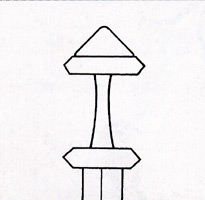 |
|
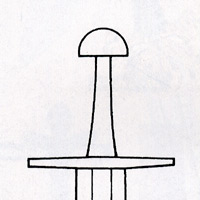 |
|
Hilt form A: from the
period around 800/900, mainly ascribed to the Vikings but
used almost everywhere in Europe.
|
|
Hilt form B: mushroom shape
from the period around 1000/1050 |
|
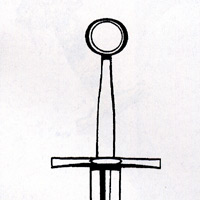 |
|
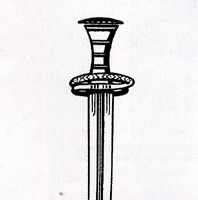 |
|
Hilt form C: disc pommel
from the period around 1200-1400, a shape that lasted for
200 years or so. Many variations were developed from the
disc-shaped pommel. |
|
Hilt form D: battle sword
dated around 1500 |
|
The nobility in particular have always been fascinated by
high-quality bladed weapons, as the collections on display
in old castles show. What still fascinates many people
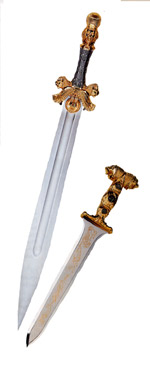 |
today is the remarkable and often very precise
workmanship of the old swordsmiths, with some of the processes
involved still shrouded in mystery. The following are a few
famous weapons in history.
Sword and dagger from the time
of Nebuchadnezzar II.
Nebuchadnezzar II was an imposing figure in Chaldean
Babylon. He was a great statesman, general and builder
with outstanding capabilities. It was during his reign
that the city of Babylon was redesigned on the Euphrates.
It became the most splendid city of its time, with many
world-famous buildings.
|
|
|
The sword of the Celts
The Celts were an Indo-Germanic people living between
Burgundy and Austria. Over the course of time they were
displaced as far as Ireland, where their heritage is still
most pronounced, by the influx of Germanic tribes and the
northward progress of the Romans. Central Europe has the
Celts to thank for its first specific artistic style.
Julius Caesar also spent seven years fighting the Celts.
He reported that the Celts decapitated their enemies and
preserved the heads in cedar oil to display them to
visitors.
|
|
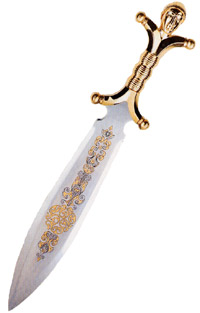 |
|
Celtic dagger from
France dating from the La-Tene period around the
3rd/2nd Century BC. The head at the end of the hilt
is a particularly striking feature of this dagger.
|
|
|
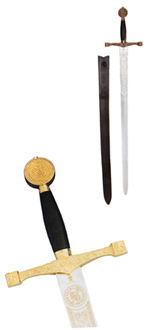 |
Excalibur, the sword of King Arthur
According to legend, Excalibur was the magic sword of King
Arthur of Britain. He was the son of King Uther Pendragon
and received his education from an old, wise man named
Merlin until the age of eighteen. According to an old
prophesy King Arthur was destined to become one of the
greatest kings of Britain, and the legend confirms this.
He was assisted by the Knights of the Round Table, an
order which he called into being. He was a brave, just and
noble monarch, which made him very popular with his
people. The magical properties of his sword helped him to
overcome the enemies of the crown.
|
Balmung, the magic sword of Siegfried
 The
life of Siegfried is known to us from ancient writings. The saga
also reports at length on the Nibelungen sword Balmung. After
his death, his wife Krimhild was able to avenge his murder by
Hagen using this sword. The hilt features two dragons with whom
Siegfried fought, while the quillon depicts a Valkyrie with a
chariot. The pommel is decorated with the royal crown of Xanten
and the flames of Iceland. The
life of Siegfried is known to us from ancient writings. The saga
also reports at length on the Nibelungen sword Balmung. After
his death, his wife Krimhild was able to avenge his murder by
Hagen using this sword. The hilt features two dragons with whom
Siegfried fought, while the quillon depicts a Valkyrie with a
chariot. The pommel is decorated with the royal crown of Xanten
and the flames of Iceland.
WingTsun-Welt
|







 The
life of Siegfried is known to us from ancient writings. The saga
also reports at length on the Nibelungen sword Balmung. After
his death, his wife Krimhild was able to avenge his murder by
Hagen using this sword. The hilt features two dragons with whom
Siegfried fought, while the quillon depicts a Valkyrie with a
chariot. The pommel is decorated with the royal crown of Xanten
and the flames of Iceland.
The
life of Siegfried is known to us from ancient writings. The saga
also reports at length on the Nibelungen sword Balmung. After
his death, his wife Krimhild was able to avenge his murder by
Hagen using this sword. The hilt features two dragons with whom
Siegfried fought, while the quillon depicts a Valkyrie with a
chariot. The pommel is decorated with the royal crown of Xanten
and the flames of Iceland.